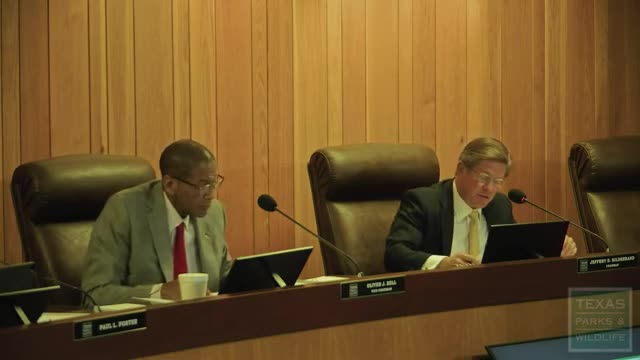Texas Coastal Fisheries director Robin Rikers reviews oyster fishery status and challenges
May 22, 2025 | Texas Wildlife Services, Departments and Agencies, Executive, Texas
This article was created by AI summarizing key points discussed. AI makes mistakes, so for full details and context, please refer to the video of the full meeting. Please report any errors so we can fix them. Report an error »

The Texas Parks and Wildlife Department (TPWD) held a significant meeting on May 22, 2025, focusing on the status of the oyster fishery in Texas, a vital resource for both the economy and the ecosystem. Robin Rikers, the director of Coastal Fisheries, presented an overview of the current state of the oyster industry, highlighting both challenges and strategic initiatives aimed at revitalizing this crucial sector.
One of the key points discussed was the decline in oyster harvests, which have plummeted from a peak of nearly one million sacks annually to around 200,000 sacks in recent years. This decline is attributed to various factors, including severe weather events and habitat degradation. Rikers emphasized the importance of protecting oyster habitats, noting that oysters play a critical role in maintaining ecological balance and providing food resources.
The meeting also addressed the ongoing efforts to support the commercial oyster mariculture industry, which has seen some regulatory changes aimed at easing operational burdens. These include reduced fees and adjustments to size limits for harvested oysters, which are expected to benefit local oyster farmers. Additionally, an economic impact study is underway to better understand how investments in mariculture can stimulate job creation and economic growth in the region.
Stakeholder engagement was a recurring theme, with Rikers mentioning the establishment of an oyster advisory committee that includes representatives from industry, academia, and non-governmental organizations. This committee aims to foster collaboration and ensure that restoration efforts are effectively coordinated.
Another significant topic was the oyster buyback program, which has garnered interest from license holders. As of the meeting, 81 licenses had been submitted for buyback, indicating a positive response from the industry. The buyback program is designed to reduce the number of active licenses, thereby allowing for more sustainable management of the oyster resource.
Commissioners expressed concerns about the sustainability of the oyster fishery and discussed potential regulatory changes, including revisiting license renewal fees and the types of dredges used in harvesting. There was a consensus on the need for a more aggressive approach to managing the fishery, ensuring that both the economic viability of the industry and the health of the oyster reefs are prioritized.
In conclusion, the meeting underscored the importance of balancing economic interests with environmental stewardship in Texas's oyster fishery. As the TPWD continues to navigate the complexities of this industry, the outcomes of these discussions will play a crucial role in shaping the future of oyster harvesting in the state, ultimately benefiting both the local economy and the ecosystem.
One of the key points discussed was the decline in oyster harvests, which have plummeted from a peak of nearly one million sacks annually to around 200,000 sacks in recent years. This decline is attributed to various factors, including severe weather events and habitat degradation. Rikers emphasized the importance of protecting oyster habitats, noting that oysters play a critical role in maintaining ecological balance and providing food resources.
The meeting also addressed the ongoing efforts to support the commercial oyster mariculture industry, which has seen some regulatory changes aimed at easing operational burdens. These include reduced fees and adjustments to size limits for harvested oysters, which are expected to benefit local oyster farmers. Additionally, an economic impact study is underway to better understand how investments in mariculture can stimulate job creation and economic growth in the region.
Stakeholder engagement was a recurring theme, with Rikers mentioning the establishment of an oyster advisory committee that includes representatives from industry, academia, and non-governmental organizations. This committee aims to foster collaboration and ensure that restoration efforts are effectively coordinated.
Another significant topic was the oyster buyback program, which has garnered interest from license holders. As of the meeting, 81 licenses had been submitted for buyback, indicating a positive response from the industry. The buyback program is designed to reduce the number of active licenses, thereby allowing for more sustainable management of the oyster resource.
Commissioners expressed concerns about the sustainability of the oyster fishery and discussed potential regulatory changes, including revisiting license renewal fees and the types of dredges used in harvesting. There was a consensus on the need for a more aggressive approach to managing the fishery, ensuring that both the economic viability of the industry and the health of the oyster reefs are prioritized.
In conclusion, the meeting underscored the importance of balancing economic interests with environmental stewardship in Texas's oyster fishery. As the TPWD continues to navigate the complexities of this industry, the outcomes of these discussions will play a crucial role in shaping the future of oyster harvesting in the state, ultimately benefiting both the local economy and the ecosystem.
View full meeting
This article is based on a recent meeting—watch the full video and explore the complete transcript for deeper insights into the discussion.
View full meeting
